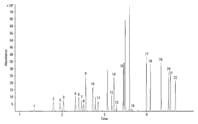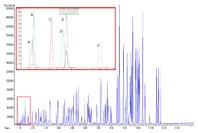Access Agilent eNewsletter, August 2014
>> Update My Profile | Subscribe to Access Agilent | Article Directory

Taking the laboratory to the water supply
By Cassie Eisele
Agilent Product Manager
The analysis of Volatile Organic Compounds (VOCs) by purge and trap is not a new application area [1]. In fact, it has been one of the principle analyses done by environmental laboratories over the last 35 years. However, looking back at the recent chemical spill in West Virginia brings up the question of how quickly a laboratory is able to react to a sudden dangerous situation.
When disaster strikes, waiting on results is not an option. There may not be time to send samples to the lab for testing. Sometimes the lab has to go to the sample.
For those critical times that call for taking the analysis out of the lab and into the field, Agilent has your solution.
Mobile system for onsite analysis
There are a variety of disasters that can affect the drinking water supply of a town or city – earthquakes, chemical spills, and general pollution. Recently there was an earthquake in China and Agilent was called upon to help provide equipment for onsite quality monitoring of drinking water sources in Beijing and Tianjin [2]. Through a strategic partnership with Teledyne Tekmar, Agilent was able to provide the equipment to help avoid a national emergency.
 Enlarge
Enlarge
Figure 1. Total ion chromatogram of water analysis for 22 target VOCs at a concentration of 25 µg/L.
Speed, good separation of compounds, and good peak shape
In response to this request, a method was developed for a Tekmar Purge and Trap connected to a 5975T Low Thermal Mass (LTM) GC/MSD to provide a mobile solution for testing potential pollutants in drinking water. Full details on this method can be found in Agilent Application Note 5991-3140EN. The benefits of the method are that there was good separation of all compounds and good peak shape. With the help of the rapid heat up and cool down time of the Agilent J&W LTM column module, the average run time of this sample analysis was less than 5 minutes (Figure 1). This rapid analysis time is crucial when reacting to a crisis situation.
The accuracy, sensitivity, and versatility you need for remote testing
For this particular method, the Tekmar Stratum purge and trap was utilized, allowing for greater portability by not requiring the use of an additional autosampler. However, it could easily be adapted for the Tekmar Atomx that has a single platform autosampler with built in purge and trap for automated dilutions.
The results of this application demonstrate that the Tekmar Purge and Trap combined with the Agilent 5975T LTM GC/MS provide the accuracy, sensitivity, and versatility for analyses in remote disaster locations.
Get the reliability you need for less
When there is a disaster such as a chemical spill, the results of water testing must be accurate, sensitive, and reproducible. With the addition of the Tekmar Purge and Trap, the Agilent GC/MS system provides results in the ppb range, giving detection levels between 0.06-0.18 ppb for the 22 compounds analyzed in China. These are examples of the reliable results you need in the field.
 Enlarge
Enlarge
Figure 2. TIC of a 20 ppb standard for the proposed USEPA Method 524.4. The insert illustrates the six light gases: Dichlorofluoromethane (A), Chlorodifluoromethane (B), Chloromethane (C), Vinyl Chloride (D), 1,3-Butadiene (E), Bromomethane (F).
Besides reliability, the average lab is also concerned about cost savings. Considering the high cost of Helium, most labs are trying to find alternative options. This can be accomplished by using Nitrogen as the purge gas for the purge and trap instead of Helium [3]. Tekmar performed a study of four drinking water sites in Ohio to test the efficacy of using Nitrogen. In the study, all compounds in the standard passed the Minimum Reporting Level (MRL) outlined in USEPA 524.4, showing this is a viable option (Figure 2). So not only can you take the lab to the supply, but you can also save money while doing it.
A complete solution for mobile analysis
These are just a few examples of how the Tekmar Purge and Trap can be used with the Agilent 5975T Low Thermal Mass (LTM) GC/MSD to test for drinking water safety in a mobile lab. These instruments deliver reliable, sensitive, and robust analyses of drinking water, so you can know if your water is contaminated when it counts and where you need it.
Learn more about how Agilent can help you with your mobile lab or water analysis by visiting our web pages.
References
- Jeffrey S. Hollis and Harry Prest, “Volatile Organic Compound Analysis Using Purge and Trap”, Agilent Application Note 5991-0029EN (2012).
- Suli Zhao, “Cooperation with the China Academy of Urban Planning and Design for Field VOC Measurement of Drinking Water sources with the Agilent 5975T LTM GC/MSD”, Agilent Application Note 5991-3140EN (2013).
- “Using Nitrogen Purge Gas for US EPA Drinking Water Methods”, Teledyne Tekmar Application Note (2012).
>> Update My Profile | Subscribe to Access Agilent | Article Directory
Figure 1.

- 1,1-Dichloroethane
- Trans-1,2-dichloroethane
- Cis-1,2-dichloroethylene
- Vinyl chloride
- Methylene chloride
- Chloroform
- 1,1,1-Trichloroethane
- Carbon tetrachloride
- 1,2-dichloroethane
- Trichloroethylene
- Bromodichloromethane
- 1,1,2-Trichloroethane
- Dibromochloro methane
- Tetrachloroethylene
- Chlorobenzene
- Bromoform
- 1,4-Dichlorobenzene
- 1,2-Dichlorobenzene
- 1,2,4-Trichlorobenzene
- 1,3,5-Trichlorobenzene
- Hexachlorobutadiene
- 1,2,3-Trichlorobenzene
Total ion chromatogram of water analysis for 22 target VOCs at a concentration of 25 µg/L.
